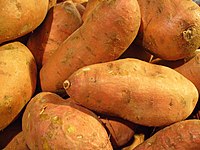
Photo from wikipedia
Sweet potato (Ipomoea batatas [L.] Lam.) is one of the most important crops in the world. Conventional genetic engineering requires delivering genetic changes to plant cells usually using Agrobacterium tumefaciens… Click to show full abstract
Sweet potato (Ipomoea batatas [L.] Lam.) is one of the most important crops in the world. Conventional genetic engineering requires delivering genetic changes to plant cells usually using Agrobacterium tumefaciens or Agrobacterium rhizogenes (Otani et al., 1993; Yu et al., 2007). Both systems through tissue culture are time-consuming, require highly trained individuals and often cause unintended changes to the genome, strongly hampering its research using genetic approaches (Figure 1a,b). Previous studies from our laboratory and collaborators showed that sweet potato is a naturally transgenic plant that contains two Agrobacterium transfer DNAs (T-DNAs) called IbT-DNA1 and IbTDNA2 (Kyndt et al., 2015). Agrobacterium rhizogenes contains two transferable T-DNA regions: TR-DNA corresponds to IbTDNA1 (harbouring the auxin biosynthesis genes iaaH and iaaM) and TL-DNA (harbouring the various Rol genes) to IbT-DNA2 (Figure 1c). At least four of the IbT-DNA1 genes and two of the IbT-DNA2 genes are expressed in every tissue type tested and IbTDNAs appear to have a role in the evolution, suggesting that this bacterium-plant relationship should not be regarded as a merely parasitic interaction, but rather as a symbiosis (Kyndt et al., 2015; Quispe-Huamanquispe et al., 2017). Agrobacterium rhizogenes is a relative of Agrobacterium tumefaciens and can be used to induce adventitious roots named ‘hairy roots’ upon wounding and infection of plant leaves or stems. Once the root-inducing T-DNA is inserted into the host genomic DNA, the new hormonal balance regulates the infected cells inducing the formation of proliferating roots, called hairy roots, emerging at the points of infection. When Agrobacterium rhizogenes harbours a binary vector, the hair roots may contain the T-DNA of the binary vector if it is cotransferred (Phelep et al., 1991). Nevertheless, hairy root cells are not expected to transfer T-DNA to subsequent generations of plants in the natural condition. Notably, the storage roots of sweet potato result from secondary thickening of the adventitious roots and have functions in both carbohydrate storage and vegetative propagation. Together, this phenomenon is suggestive of the hairy roots as a kind of adventitious root with the potential to develop into storage roots to achieve heritable genetic modifications. To test this hypothesis, we first determined whether one-step Agrobacterium rhizogenes-mediated transformation could apply to obtain heritable transgenic sweet potato plants via overexpression of b-glucuronidase (GUS) gene. The recombinant IbRPS5a:GUS plasmid was introduced into Agrobacterium rhizogenes strain K599 by freeze-thawing and used for plant transformation. Shangshu 19, a widely cultivated sweet potato cultivar in China, was employed in this study (Figure S1). Briefly, sweet potato vine cuttings were infected with Agrobacterium rhizogenes K599-IbRPS5a:GUS by wounding the nodes with a syringe. Subsequently, the inoculated vine cuttings were then directly planted in the field under natural conditions (Figure 1d, Appendix S1). The induction of hairy roots and the growth of plant were finished in the field (Figure 1e–h). PCR detection of the hygromycin phosphotransferase gene demonstrated that nearly 100% of the infected vine cuttings could produce transgenic positive storage roots (Figure 1i, Figure S2). As shown in Figure 1j, transgenic plants exhibited a high level of GUS activity, indicating the stable integration of binary vector TDNA in the genome of storage roots. Other transgenes are conducted in the same way (Figure 1k,l). Whole plants were regenerated from storage roots within 2 weeks. The overexpression of transgene in the seedlings grown from storage roots was also assessed by quantitative reverse transcription-PCR (qRTPCR) analysis (Figure 1m). Using this method, 90%–100% of the infected plants form positive storage roots within 2 months from the start of the experiments (Figure 1n). Consequently, the Agrobacterium rhizogenes-mediated method is faster, simple and more efficient than the conventional transformation methods. Furthermore, because every root meristem derives from a single cell, hairy root lines established from single root meristems are cellular clones (Costantino et al., 1984). Consequently, every transgenic storage root represents an independent transformation event.
Journal Title: Plant Biotechnology Journal
Year Published: 2022
Link to full text (if available)
Share on Social Media: Sign Up to like & get
recommendations!